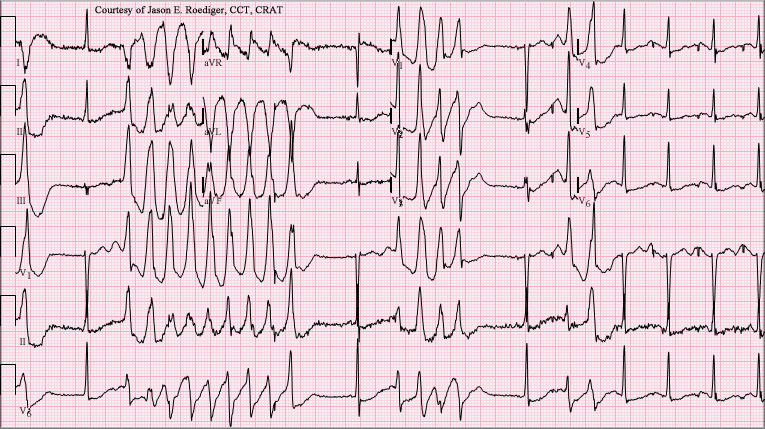Torsades de pointes electrocardiogram
|
Torsades de pointes Microchapters |
|
Diagnosis |
|---|
|
Treatment |
|
Case Studies |
|
Torsades de pointes electrocardiogram On the Web |
|
American Roentgen Ray Society Images of Torsades de pointes electrocardiogram |
|
Risk calculators and risk factors for Torsades de pointes electrocardiogram |
Editor-In-Chief: C. Michael Gibson, M.S., M.D. [1]
Overview
EKG is the main diagnostic tool for torsades de pointes. Findings include twisting of QRS complexes around the horizontal isoelectric axis. Polymorphic ventricular tachycardia is distinguished from torsades de pointes by the absence of prolongation of the QT segment.
Electrocardiogram
EKG is the main diagnostic tool in patients with Torsade de pointes. EKG findings that can be seen are:
- Progressive change in polarity of QRS about the isoelectric line occurs
- Prolonged QT interval (QT ≥ 0.60 s or QTc ≥ 0.45 s)
- Pathological U wave
- Rotation of the heart's electrical axis by at least 180º
- Preceded by short long and short RR-intervals
- Triggered by an early premature ventricular contraction(R-on-T PVC)
- Paroxysms of 5-20 beats at a rate ≥ 200 bpm
- Patients may revert spontaneously to a nonpolymorphic ventricular tachycardia or ventricular fibrillation
Background
- The peaks of the QRS complexes appear to twist around the isoelectric axis.
- Polymorphic VT is distinguished from Torsades by the absence of QT prolongation in polymorphic VT.
EKG Findings
- Paroxysms of VT with irregular RR intervals.
- A ventricular rate between 200 and 250 beats per minute.
- Two or more cycles of QRS complexes with alternating polarity.
- Changing amplitude of the QRS complexes in each cycle in a sinusoidal fashion.
- Prolongation of the QT interval.
- Is often initiated by a PVC with a long coupling interval, R on T phenomenon.
- There are usually 5 to 20 complexes in each cycle.
EKG Examples
Shown below is an EKG depicting torsades de pointes in a 56-year-old female, who had a potassium of 2.4 mmol/L and a magnesium of 1.6 mg/dL.

Copyleft image obtained courtesy of ECGpedia, http://en.ecgpedia.org
Shown below is an EKG with wide QRS complexes in a twisting manner around the isoelectric axis indicating torsades de pointes.

Copyleft image obtained courtesy of ECGpedia, http://en.ecgpedia.org
Shown below is an EKG depicting torsades de pointes.

Copyleft image obtained courtesy of ECGpedia, http://en.ecgpedia.org
Shown below is an EKG depicting polymorphic ventricular tachycardia with wide QRS complexes.

Copyleft image obtained courtesy of ECGpedia, http://en.ecgpedia.org
For more EKG examples of torsades de pointes click here.